Mars Colonisation by ZA Architects
Robots could be sent to Mars to build caves for later habitation by humans, according to a proposal for the colonisation of the planet by German firm ZA Architects (+ slideshow).
The Mars Colonisation project by ZA Architects suggests that humans could colonise the red planet by living in underground dwellings dug out of the planet's bedrock by an advance party of solar-powered machines.

"Curiosity sooner or later will bring human to Mars and wouldn't it be nice to have permanent station to explore it?" said Arina Ageeva of ZA Architects. "It seems pretty logical to use caves as the main protective structure of the colony."
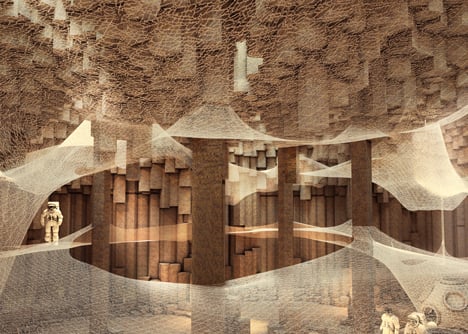
Robots would be flown to Mars to carve out large voids in the basalt bedrock, choosing areas where the rock has formed into distinctive hexagonal columns, which can be removed to create cathedral-like interior spaces. The distinctive, tightly packed stone hexagonal columns, which are also found on earth, are formed where basaltic lava has cooled rapidly.
The robots would then weave web-like structures from basalt fibres to create floors within the caves. Basalt fibres, made by extruding molten basalt, are cheaper and more versatile then carbon fibres, and could replace traditional construction materials on Mars, according to Ageeva.
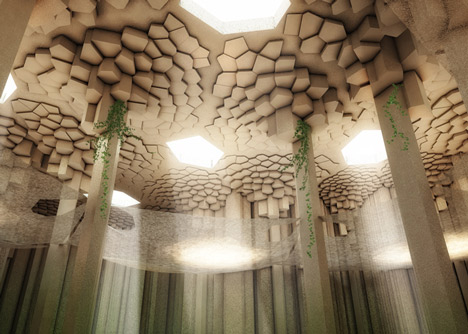
"We can weave minimal surfaces that will be used as floors on different levels in the cave," she told Dezeen. "This material is already in use in the aerospace and automotive industries. It is stronger and lighter than steel, easier to operate, fireproof and it does not corrode," she added.
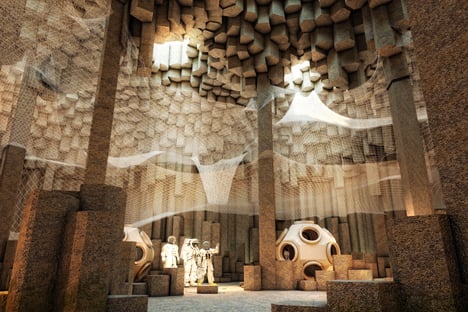
The Mars colonisation project was undertaken by Dmitry Zhuikov, Arina Ageeva, Krassimir Krastev of ZA Architects as part of a research project at Dessau Institute of Architecture (DIA), HS Anhalt, in Germany.

Ageeva believes humans will be sent to live on Mars within a decade, and cited the Mars One project that plans to send volunteers to establish a colony on Mars by 2023. "Right now it is may not be possible, because such robotics do not exist, but generally we don't see anything unrealistic in this proposition," she said.

We've featured a number of space-related projects recently, including an orbiting factory that will use 3D printing and robots to fabricate giant structures in space and a concept for 3D printing buildings on the moon using lunar soil.
See more features about space »
See more robots on Dezeen »
Here's more from the architects:
Mars Colonisation
The purpose of the project is in research of the possibility to build permanent settlements on Mars, using robotics and local materials, thus reduce the price and risks. At the moment there are several crucial restrictions, first of all unreliability, high cost and size limitation of cargoes that can be delivered there.
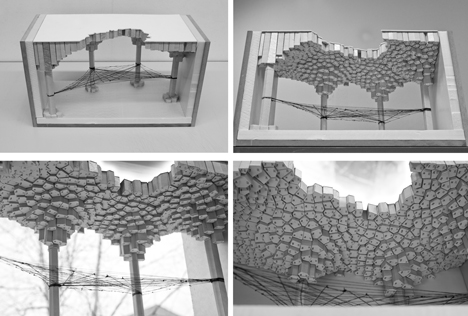
Further, building works that can be performed on the Mars are highly restricted due to severe conditions. Idea of this project is to split construction works on two general steps: First - creation of overall big shell that will be equipped with residential, technical and other units, which is the second.
First part is to be done by the robots using only local materials. Martian surface is primarily composed of the basalt - igneous rock formed from the rapid cooling of basaltic lava. During the cooling it forms topology of the tightly packed hexagonal in section columns. Idea to use the digging robots that can hew cave system, using benefits of this topology is inspired by the Fingal's Cave. This solution allows to avoid supply from the Earth, only robots are needed.
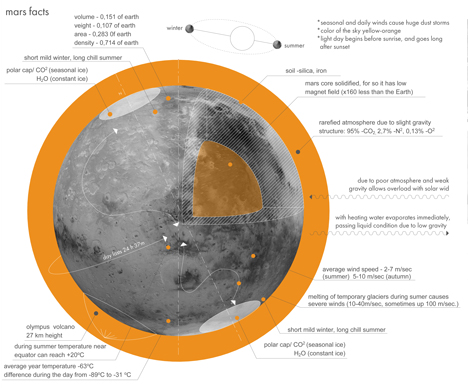
After cave is done, astronaut mission is sent to the Mars. Using ready-assembled compact facilities they must arrange water and oxygen supply from the soil glacier and mount basalt processing plant. Robot supply plant with the crushed rock, output - basalt wool, with which the same robots insulate the walls of the cave, and basalt roving, from which another weaving robots can make the spatial spider-like web that will be used as spaces and constructions to hold the domestic and technical facilities.
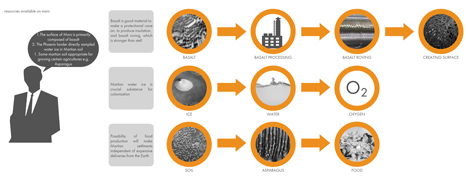
According to NASA, some martian soil appropriate for growing certain agricultures. When construction is finished and contour of the cave is enclosed it is possible to arrange agricultural processes and supply base with food.

Colonisation stages:
1. Rocket with digging robots and solar power supply units are sent to the Mars
2. Robots drop-off on the surface
3. Robots analyze basalt columns on strength value, then each chooses a weakest pillar that equidistant from the others - it is a start position
4. Robots drill basalt, moving down and increasing diameter of withdrawn rock with each step, until it reaches strong pillars that remain as columns
5. Crushed rock set aside to form network of the ramps, in order to protect skylight holes from the wind and dust
6. After caves are ready human expedition travel to Mars
7. Astronauts finish the construction and arrange technical facilities as water, oxygen, basalt processing line, etc.
8. Using generated basalt roving, robots weave spatial spider-like web, that will be used as spaces and construction to hold domestic and technical facilities
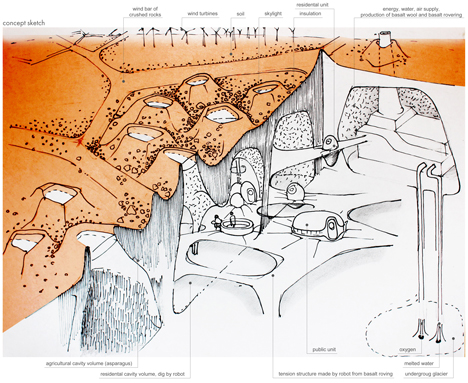
name: mars colonization
status: concept
location: Mars
function: industrial, public, residential
architects: Dmitry Zhuikov, Arina Agieieva
curator: Krassimir Krastev
year: 2013